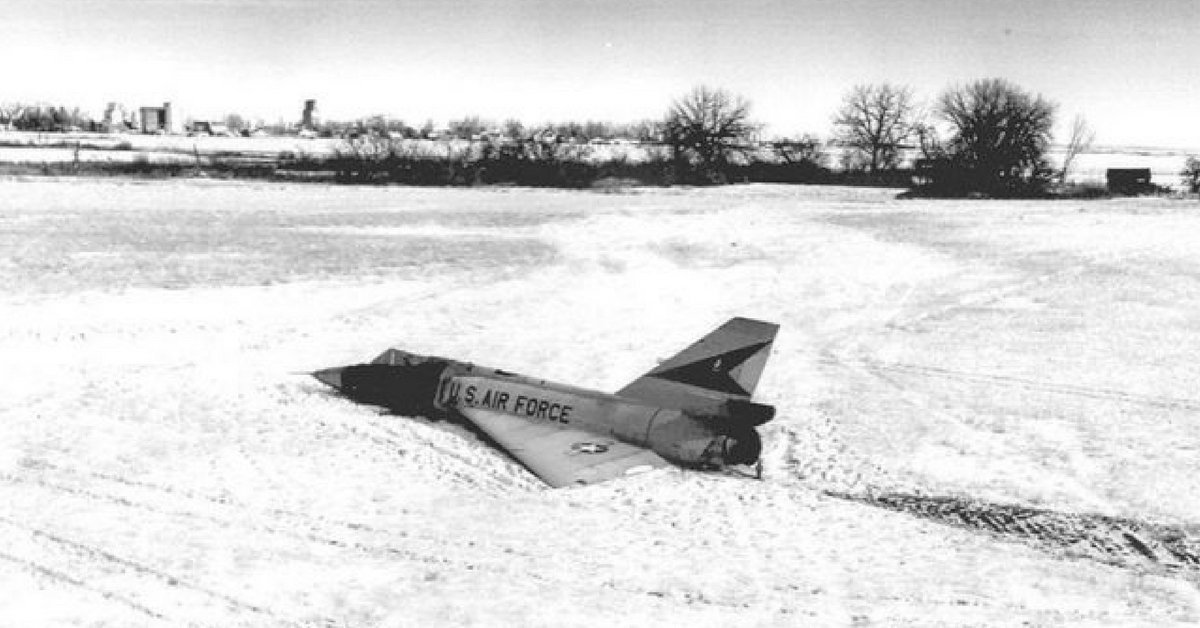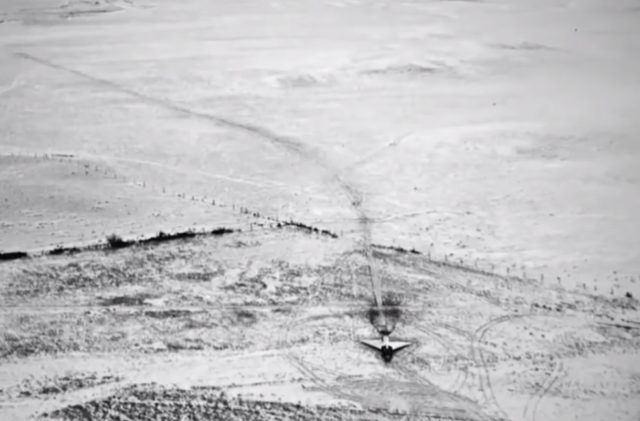In 1970, a plane got fed up with its pilot so it hatched an audacious plan. First, get rid of the pilot. Second: land. Third: enter history. The result was amazing.
On February 2, 1970 four pilots of the 71st Fighter-Interceptor Squadron were to take off from the Malmstrom Air Force Base in Montana. They were to do so on Convair F-106A-100-CO Delta Darts and engage in mock combat.
But one plane had ideas of its own. Just as it was about to take off, its drag chute deployed – forcing its pilot to abort.
So then there were three. Major Tom Curtis was to “fight” Major Jim Lowe and Captain Gary Faust. No problem – they’d been through this before. Or so they thought.
The three split up to begin their dogfight. Once they were 20 miles apart, ground controllers gave them all different vectors to ensure that each had a fair chance. From that point on, they could do whatever they felt was necessary to win.
Curtis went after Faust first, so he accelerated to Mach 1.90. The plan was to force Faust into a vertical engagement that would put him at a disadvantage.
The three planes zoomed toward each other and overshot. Curtis climbed, forcing the other two to try and catch up. Having entered the climb faster, he had the advantage, but it couldn’t last.
So he switched to vertical scissors – using his speed to climb and dive in a spiral while doing a barrel roll. He then took it a step further by widening his spirals, forcing the other two to break out of their own climb.
Once past 38,000 feet, Curtis did a high-G rudder reversal – turning and rolling to reduce his thrust, thereby forcing his “enemy” to overshoot him. It worked… sort of. Faust took the bait, which probably annoyed his plane.
Tail number 58-0787 shuddered, then went into an accelerated stall – meaning it suddenly plunked its nose downward. Then it made a beeline toward the ground.
Curtis saw it all. From his angle, it looked as if the plane’s tail was doing a slow circuit around its wobbling nose – disaster! It’s called a flat spin. And once an F-106A does that, it’s almost as good as dead.
Fortunately, the men were seasoned, professional pilots. Lowe’s calm voice came over Faust’s radio – carefully going over spin recovery procedures step-by-step. Faust followed them all faithfully, trying to maneuver the plane’s nose at an angle that would break its spin.
He set the plane’s trim to the take-off position, but 58-0787 refused to respond. Trimming frees the pilot from having to exert constant pressure on the controls, but it did no good. Nothing worked.
There was only one thing left to do – activate the drag chute. This wasn’t meant to be used in flight, however. It’s only for extra braking when a plane lands. The hope was that it would slow the plane down enough so Faust could get it at the angle needed to break its spin.
So he deployed it, and off it went… wrapping itself around 58-0787’s vertical stabilizer. Perhaps even more annoyed by that, the F-106A continued its downward spiral of doom. Faust had exhausted all of his options.
And having fallen below the 15,000 feet mark, he had also run out of time. If he was to survive, he had to bail – so he did.
It was the signal that 58-0787 was waiting for. The blast that catapulted Faust out was exactly what was needed to push its nose straight down.
The plane broke out of its spin, leveled off, and resumed flying in a straight line – albeit with a slight left and right wobbling. Even better, Faust had set the trim to take-off, which was similar to the landing trim position. And best of all, he had moved the throttle to “idle” – putting the plane into a steady gliding descent.
Except that he was no longer in it. Lowe saw it all and couldn’t help laughing, “Gary? You better get back into that thing!”
But 58-0787 was having none of it. Freed of its human, at last, it flew off into the vast blue skies above northern Montana. Faust, meanwhile, could only watch in awe as his plane continued to fly on without him as he slowly parachuted down into the snow-covered Bear Paw Mountains.
Curtis and Lowe radioed his position and headed back to base. All three hoped that wherever 58-0787 crashed, it wouldn’t be on anyone below. As for Faust, he was rescued shortly after landing by a group of Native Americans on snowmobiles.
But 58-0787 had no intention of crashing. Traveling at about 175 knots, it reveled in its new-found freedom till it reached the town of Big Sandy (population: 598 in 2010) in Chouteau County. Seeing a lovely snow-covered alfalfa field, it made a slow, steady downward glide till it touched ground.
Delighted by the snow, it continued to slide, making sure to stay steady and avoid letting either wing touch the earth. But there was trouble ahead. Cutting across the field at an angle to its approach lay a low, stone wall with only a narrow gap in the middle.
So 58-0787 slid to the right, did a 20° turn, slipped through the opening, and continued on into the next field where it finally stopped before an astonished farmer. The man called the sheriff, of course, who called the base.
They asked him to assess the damage, but each time he tried to get close, 58-0787 would jiggle and dance, trying to get away. Finally, the authorities told him to just let the thing be – it would run out of fuel, eventually.
By the time the military got there, it had done just that – almost two hours later. So they took off its wings and hauled it back to base. To their surprise, except for some superficial scratches on its underside, it was still flight-worthy and later put back in active service.
They called Faust the “Cornfield Bomber” after that, but he was not a bomber. Nor did 58-0787 land in a cornfield. It now rests at the National Museum of the US Air Force, restored to its former glory, and no doubt reminiscing about its Montana adventure.

58-0787 resting on an alfalfa field in Montana

58-0787 after making a right turn to avoid the stone wall

Major Gary Foust (retired) with 58-0787 (also retired) behind him

